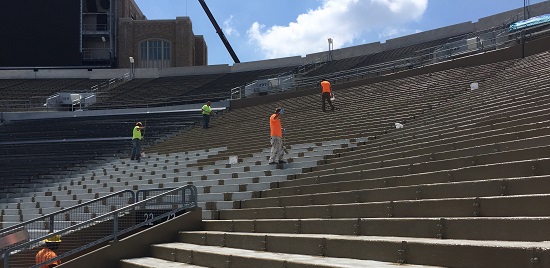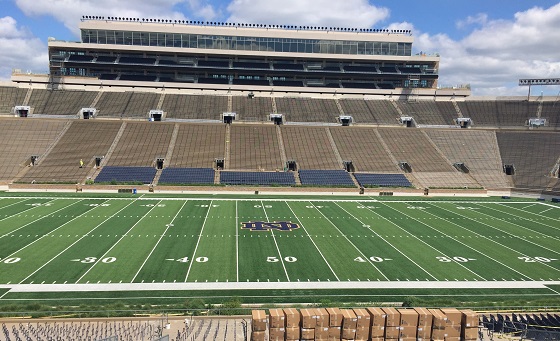The famed tunnel sign at Notre Dame Stadium, built in 1929 and home to the 11-time national championship football program at the University of Notre Dame, reads “Play Like a Champion Today.” For the nearly 80,000 fans and prospective recruits that visit on Saturdays in the fall to cheer on the Fighting Irish, they’d like the legendary stadium to look worthy of a champion, too!
Over the past decade, that’s exactly what a crew of contractors at Pennsylvania-based Quinn Construction, Inc. has helped do. Though Notre Dame is several hundred miles away in South Bend, Indiana, regional engineering consultant Simpson Gumpertz & Heger selected Quinn for the stadium’s latest renovation project based on its own prestigious history.
“We did a job at Fisher Field at Lafayette College [in Pennsylvania] back in 2005, and it was the same engineer,” said Shawn Quinn, vice president at Quinn Construction, which has ~75 total employees. “He asked us if we would go out to Indiana — we didn’t know it was Notre Dame at the time — and we said, ‘Sure’!”
Making History
From there, the crew won an initial revamp bid. Beginning in March 2007, they rehabilitated the stadium in a six-year phased approach, coating several sections per year. Notre Dame was happy with that system and it held up extremely well, according to Quinn. So when a new $400-million expansion was announced in 2014, the contractor was a natural fit for the Golden Domers’ game plan.
“An addition was put on, so the university decided to recoat the stadium in a new color to match the addition,” Quinn said. “They changed the color scheme from gray to dark maple. The architect thought it would look better, that the color would look closer to their gold. It looked good, better than the gray! With the new blue seats, it looked really nice.”
Since the crew had already worked on the stadium a few years back, it felt in some ways like the project’s “second half.” That brought both opportunities and challenges.
“Everything was already coated, so we were just putting another topcoat on,” Quinn explained. “But the color change did make our job harder. Certain things that normally wouldn’t get coated, like the brackets of seating, had to be coated. The detail had to be precise. We had to make sure to get in all the nooks and crannies. Coating steel brackets wasn’t what I considered waterproofing, but we had to do that because of the color change.”
Gold-Star Job
Team success on the gridiron is often credited to a family-like atmosphere, and that was literally the case for Quinn, whose son Shawn Quinn Jr. headed up the crew on the 500,000-square-foot (46,451.5 m²) job as the project manager.
The latest bid specified job completion between March and August 2017, with September as a hard deadline for the start of football season. The stadium was closed to the general public, but work areas were fenced and barricaded since a few special events still occurred.
Quinn’s crew was as large as 28 workers from March through May, when old expansion joints were replaced with new ones from Willseal. “We were cutting out the old expansion joints and putting new ones in,” Quinn explained. “The expansion joints were past their warranty, and they wanted to upgrade them and try new systems. The other system had a built-in gutter, and they thought they were having some issues.” The crew also performed minor concrete repairs during this time using a Bosch chipping gun.
Standard personal protective equipment (PPE) gear was worn each day, including hard hats from MSA Safety, safety glasses, protection gloves, vests, and half-mask respirators with 3M filters when doing any grinding or cutting for expansion joints. Because broadcasting aggregate would not be required, the crew didn’t have to worry about silica exposure for the project’s coating portion. “That’s one of the beauties of the coatings we were using,” Quinn said. “There was less equipment to wear. This is the product of the future, I think.”
After joints were installed and minor concrete work repaired, the final three months consisted of coating. With an 11-man coatings crew, the crew moved in phases throughout the stadium. Protocols varied slightly based on individual areas, but surface preparation usually consisted of scrubbing a trisodium phosphate (TSP) environmental cleaner with a brush to remove existing greases and oils, followed by washing with a 3,500 psi (24.1 MPa) pressure washer from DeWalt.

In areas with bare concrete repairs or prior coating damage, a low-odor NEOGARD 7797 primer was applied at an average of 6 mils (152.4 microns) dry film thickness (DFT) to ensure bonding. Then, various high-solids NEOGARD aliphatic urethane topcoats in dark maple were applied at an average of 20 mils (508 microns) DFT. The lower bowl, vomitory ramps and walls, concourses, restrooms, and closets received the NEOGARD FC7545, while food and beverage concession areas received the NEOGARD 70805, which includes added chemical resistance. Aluminum oxide was applied on the ramps; they required more slip resistance due to inclines.
The coatings were applied using 18-inch (45.7 cm) and 9-inch (22.9 cm) rollers for smaller areas, and 24-inch (61.0 cm) squeegees for larger ones. “In the seating areas, we were pouring [the coating] out and using rollers to keep it thick enough. Up top, we would squeegee the main areas and then backroll it in because we had a bigger surface to move it around.”
Since coating was just part of the massive stadium upgrade, one major challenge was keeping numerous other trades — including electricians, WiFi specialists, carpenters, plumbers, and many more — away from coating areas for a few days. “Keeping people out of our prepping area and keeping them out until [the coatings] cured was quite a challenge,” Quinn said. “Communication was key. We also tried to get in front of the seating guys. Wherever they weren’t yet, we went out and coated. That way we didn’t have to protect the new blue fiberglass seats.”
Engineering consultants hovered over the crew throughout the project, routinely using pull test machines for quality assurance until the final days. But from Quinn’s perspective, that was all positive. “They were great to work with,” he said. “We like the projects when the engineers are on site two or three days a week. It usually works well for us.”
Team Success
By the time the project clock expired before the 2017 season, the contractor had added even more points to its final score. “They were very happy,” Quinn Jr. said of the client. “It’s the same engineers, and it’s been the same team for 10 to 11 years out there. I think that says a lot right there, that they wanted to keep working with us.”
But the client wasn’t the only entity to reap benefits.
“One of the keys to the project, in my mind, was the team atmosphere,” Quinn Jr. said of his crew. “Everyone was pointed in the same direction, with the same goal in mind. The guys loved the atmosphere, too. They got to see the tunnel, and even slap the ‘Play Like a Champion’ sign. It’s such a good team atmosphere between the engineer, owner, and ourselves. Everyone became friends by the end of the job when they were hanging out after work together.”
With Notre Dame entering November 2018 undefeated and ranked in college football’s top five nationally, the contractor hopes the stadium’s aesthetic appeal might even be responsible for a small portion of the program’s success.
“With the TV coverage, we see the stadium more and more. I like to think we have a part in the team winning, too,” Quinn quipped. “If they win the national championship, we’re taking credit for it!”
As the fight song goes, it’s “cheer, cheer for old Notre Dame.” And for Quinn Construction!
